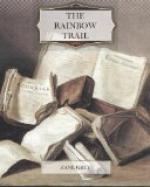This communication lent an added zest to the journey. Shefford could hardly believe the truth that his eyes and his ears brought to his consciousness. He turned in behind Withers and rode down the rough trail, helping the mustang all in his power. It occurred to him that Nack-yal had been entirely different since that meeting with his mother in the draw. He turned no more off the trail; he answered readily to the rein; he did not look afar from every ridge. Shefford conceived a liking for the mustang.
Withers turned sidewise in his saddle and let his mustang pick the way.
“Another time we’ll go up round the base of the mountain, where you can look down on the grandest scene in the world,” said he. “Two hundred miles of wind-worn rock, all smooth and bare, without a single straight line—canyon, caves, bridges—the most wonderful country in the world! Even the Indians haven’t explored it. It’s haunted, for them, and they have strange gods. The Navajos will hunt on this side of the mountain, but not on the other. That north side is consecrated ground. My wife has long been trying to get the Navajos to tell her the secret of Nonnezoshe. Nonnezoshe means Rainbow Bridge. The Indians worship it, but as far as she can find out only a few have ever seen it. I imagine it’d be worth some trouble.”
“Maybe that’s the bridge Venters talked about—the one overarching the entrance to Surprise Valley,” Said Shefford.
“It might be,” replied the trader. “You’ve got a good chance of finding out. Nas Ta Bega is the man. You stick to that Indian. . . . Well, we start down here into this canyon, and we go down some, I reckon. In half an hour you’ll see sago-lilies and Indian paint-brush and vermilion cactus.”
. . . . . . . . . . .
About the middle of the afternoon the pack-train and its drivers arrived at the hidden Mormon village. Nas Ta Bega had not returned from his scout back along the trail.
Shefford’s sensibilities had all been overstrained, but he had left in him enthusiasm and appreciation that made the situation of this village a fairyland. It was a valley, a canyon floor, so long that he could not see the end, and perhaps a quarter of a mile wide. The air was hot, still, and sweetly odorous of unfamiliar flowers. Pinyon and cedar trees surrounded the little log and stone houses, and along the walls of the canyon stood sharp-pointed, dark-green spruce-trees. These walls were singular of shape and color. They were not imposing in height, but they waved like the long, undulating swell of a sea. Every foot of surface was perfectly smooth, and the long curved lines of darker tinge that streaked the red followed the rounded line of the slope at the top. Far above, yet overhanging, were great yellow crags and peaks, and between these, still higher, showed the pine-fringed slope of Navajo Mountain with snow in the sheltered places, and glistening streams, like silver threads, running down.




